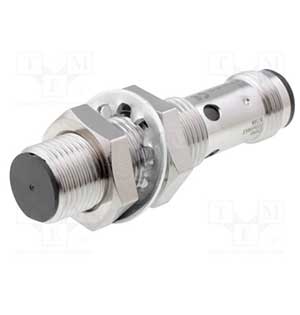E2B-M12KS04-M1-C1: Omron NPN Proximity Sensor
The technical specifications for the Omron NPN Proximity Sensor E2B-M12KS04-M1-C1:
-
- Sensor Head diameter: M12
- Mounting: Flush | Shielded
- Sensing Distance: 4mm
- Body Length: Short Body (51mm)
- Output Configuration: NPN
- Operation Mode: NO
- Connection: M12 Connector
- Power Supply Voltage: 10 to 30 VDC
- Sensor Head diameter: M12
Original price was: ₹1,600.00.₹800.00Current price is: ₹800.00.
In stock
Omron NPN Proximity Sensor E2B-M12KS04-M1-C1 Technical Specifications:
| Sensor Head (Dia) | M12 (12mm) |
| Installation | Flush | Shield |
| Sensing Distance | 4mm |
| Body Length | Short (51mm) |
| Output Configuration | NPN |
| Switching | NO (Normally Open) |
| Connection | M12 Connector |
| Differential travel | 10% max. of sensing distance |
| Detectable object | Ferrous metal (The sensing distance decreases with non-ferrous metal.) |
| Standard sensing object | 8 × 8 × 1 mm |
| Response frequency | 1,000 Hz |
| Power supply voltage | 10 to 30 VDC. (including 10% ripple (p-p)) |
| Current consumption | 10 mA max |
| Indicator | Operation indicator (Yellow LED) |
| Protection circuit | Output reverse polarity protection, Power source circuit reverse polarity protection, Surge suppressor, Short-circuit protection |
| Ambient air temperature | Operation and storage: -25 to 70ºC |
| Ambient humidity | Operation and Storage: 35 to 95% |
| Voltage influence | ±1% max. of sensing distance in 24 V ±15% |
| Standard and listings | (1) IP67 (IEC60529) (2) EMC (EN60947-5-2) |
| Material Case | Stainless steel (1.4305 (W.-No.), SUS 303 (AISI), 2346 (SS).) |
| Material Sensing surface | PBT |
| Material Cable | None |
| Material Clamping nut | Brass-nickel plated |
People Also Ask
What is NPN proximity sensor?
NPN Proximity Sensor is a type of sensor that utilizes an NPN transistor in its output mechanism. These sensors provide an active LOW output configuration. Essentially, when an object comes within the sensor’s detection range, the sensor’s output is grounded. This action effectively completes the circuit, allowing current to flow through any connected load. Due to this operational characteristic, NPN proximity sensors are commonly referred to as ‘sinking’ sensors, as they sink the current to the ground upon activation.
How do you test a NPN proximity sensor?
Observe the voltage on the open load wire using a voltmeter as the sensor becomes energized. For an NPN sensor, the voltage will fluctuate between an ‘open’ state and ground. In practical terms, this means the voltmeter will typically show a reading close to 0 volts when the sensor is energized (object detected) as it connects the output to ground.
In contrast, a PNP sensor’s behavior is different. This type of sensor will alternate between 0 volts and the supply voltage (e.g., 24 volts) depending on whether it is energized. So, when an object is detected, a PNP sensor will show a voltage close to its supply voltage, such as 24 volts.
What is difference between PNP and NPN sensor?
Difference between NPN and PNP sensors lies in how they handle output signals, despite both being capable of amplifying signals and switching larger currents. Both sensor types are equipped with positive and negative power leads. However, in their PNP sensors generate a positive output signal for your industrial control inputs, whereas NPN sensors generate a negative signal when in the “on” state.
The Omron E2B-M12KS04-M1-C1 is a specific model of Inductive Sensor, M12 diameter, 4mm Sensing Distance, Flush, Omron NPN Proximity Sensor, Short (51mm), NO(Normally Open), M12 Connector. Its operating voltage is 10-30V.
IndMALL offers a reliable and well-stocked supplier of proximity sensors, including the Omron E2B-M12KS04-M1-C1. Proximity sensors from Omron and various brands, all at competitive prices and with stock availability.



